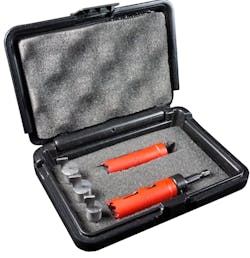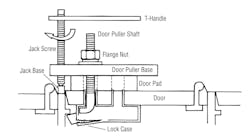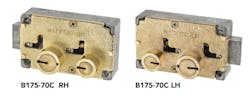2 Opening Methods for the Guardian 6832 Safe Deposit Lock
There are two different methods of defeating the Guardian 6832 safe deposit lock. Each method has its own strengths, and having multiple tools in the toolbox ensures adaptability for different situations.
Both methods are highly effective and having multiple techniques available increases success rates in different scenarios. While the screwdriver method offers a manual, controlled approach, the door puller method provides a quick and forceful solution where applicable. By understanding the strengths and limitations of each technique, locksmiths can adapt to different lock types and configurations while minimizing damage and maximizing efficiency.
Method 1: Framon Safe Deposit Killer Kit
This technique utilizes mechanical force to manipulate the lock's internal components and retract the bolt. Here are the steps, described in greater detail below:
- Insert the Guard Key – This is crucial, as without it, there will be too much friction to force the lock open.
- Use a Medium Flat Blade Screwdriver – Begin bending the lock's levers and creating a larger gap. Insert a Heavy-Duty Flat Blade Screwdriver – This tool bends the levers and guide post out of the way, allowing the lock bolt to retract.
The Framon Mfg. Safe Deposit Killer kit comes with an awesome little guidepost that fits directly into the keyhole and perfectly centers the hole saw. The kit comes with three different posts and two different diameter hole saws that go directly into your drill, even a cordless drill like my Milwaukee Tools model. It slides right over the post that you’ve inserted into the keyway. In no time flat, it drills out the outer lip and allows the nose to be pulled, along with the post, and then you can dig out all the little pieces that you need to remove. This process took under 30 seconds and was extremely effective.
Once that’s removed, you can see a tiny bit of space in the upper lefthand corner. Use a flat -blade screwdriver to start bending it over. Start with a smaller one until we have that lip created, and then you can use a much larger one – as big of a screwdriver that will fit in the hole. I’ve got that large flat-blade screwdriver attached to some vise grips. That’s how much force it takes to push those levers out of the way and retract the bolt.
This is not like the Sargent and Greenleaf locks where the levers fall out of the way and you simply slide the bolt back. No, this is a heavy duty force that requires a large amount of pressure and leverage.
This is a complicated opening. Where the arrow is pointing in photo 7), normally these gates would have to line up with the levers and it would allow the lock bolt to be retracted. What you see through that hole that we created is just that little, tiny portion down at the bottom. That’s all we have to manipulate this entire slide and we’re forcing everything back. You MUST have the guard key inserted, or you won’t have enough pressure to open the door.
Limitations:
- This method requires a working guard key.
- If excessive force is needed, there is a risk of damaging internal components beyond repair.
This is my go-to method. I’ve done this quite a few times and I’ve done it the hard way. Trust me, this is definitely the way to go. I really like this product and it makes easy, clean work of everything.
For more information, visit https://www.framon.com/index.php/project/safe-deposit-killer-kit/
Method 2: Lockmasters Safe Lock Neutralization Kit
- Position the Door Puller – Align it against the safe deposit box door.
- Apply Screw Pressure – The force shears off the lock bolt entirely, allowing the door to open.
Start off with the post that comes with the Framon kit and that same hole saw. Both these processes start out the same way and you have to pull the nose and the post out of the hole.
Once you have the nose and post out of the hole, you can put the jack screw into the forked end of the door puller tool. You don’t want to thread it through all the way; you just want to get it flush.
Next, slide the J-hook piece right into the hole we just drilled. Then we try to protect the door as much as possible with some paper, folded over several times, or cardboard or metal. Once that paper or cardboard is placed, apply pressure until the door opens.
There’s a bit of a learning curve on getting the right amount of pressure and getting that door puller screw to hold tight. Once you have everything lined up, you can see the door beginning to pull open. Continue and then finish with a large flat-blade screwdriver.
Now the door has been pulled. The lock bolt has been sheared completely off and the levers were not forced in.
Advantages of this method:
- This method requires a working guard key.
- If excessive force is needed, there is a risk of damaging internal components beyond repair.
Challenges:
- If the safe deposit box is on the edge of the nest, there is little room for the screw post to rest on, increasing the risk of damaging the door, container, or nest.
- Requires careful setup to avoid unnecessary damage.
For more information, visit www.lockmasters.com.
Wayne Winton is the owner of Tri-County Locksmith Services, located in Glenwood Springs, Colorado. For more information, check out Wayne’slockshop.com.
To watch the full video, scan the QR code or go to https://www.youtube.com/watch?v=xfGMxkCZ_J8.
Wayne Winton
Wayne Winton is the owner of Tri-County Locksmith Services, located in Glenwood Springs, Colorado.






